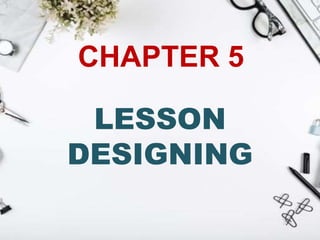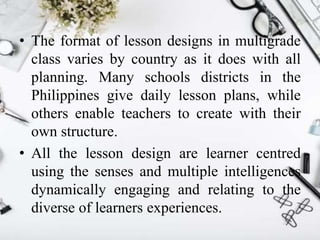CHAPTER-5-multigrade-teaching.pptx
- 2. INTENDED LEARNING OUTCOMES At the end of the chapter you should be able to: Explain the importance of preparing lesson designs; Identify different steps in various formats in lesson designing; and Create lesson designs using different formats as applied in Multigrade teaching.
- 3. LESSON 1 DESIGNING IN MULTIGRADE TEACHING
- 4. Read the story below depicting two new multi grade teachers engage in a conversation . Teacher 1: I’m terrified of my new teaching assignments in a multigrade class. I’m feeling overwhelmed by the tasks that lie ahead of me. Teacher 2: I’m feeling exactly the same way . Despite my positive internship experiences. I am not sure in my to handle the vast responsibilities of being a multigrade teacher, particularly in the creation of lesson designs. Teacher 1: I don’t think I’m very good at lesson designing. Teacher 2: I’m curious, what exactly is a lesson design in a multigrade class? Is it going to make it easier for me to start teaching?
- 5. 1. Describe the dilemma of the two new multigrade teachers. 2. What is your feeling about their dilemma ? 3. If you were the multigrade teachers, what are your perspective towards multigrade teaching in general, and lesson designing , in particular? 4. What would make easier for you to begin teaching in multigrade class?
- 6. A lesson designing is a blue print for the teacher or a template for facilitating a lesson. It is the major pillar of the educational structure and the center of learning (Mastropieri & Scruggs, 2007). According to Nesai and Heidari, 2014, it contains the objectives (what students in each grade level should learn), how the objectives will be fulfilled (the method of delivery and procedure), and a methodology to assess how well the objectives were met (assessment). One of the most important aspects of the educational process is the lesson design or plan.
- 7. A multigrade lesson design consists of details pertaining to the lessons, the outcomes that will be addressed by grade levels, the methods that will be used which involved differentiation and groupings, and the materials and activities that will be included to engage and assess the students. Lesson deigning is at the heart of effective teaching. It is a creative process that allows the teacher to map out curriculum goals into skills and tasks ( Posner, 2003). It ensures continuity of learning and the integration of skills and knowledge across the multigrade curriculum. Further, it serves as a tool for evaluation for instructional approaches utilized. In other words , careful lesson designing leads to an effective Multigrade learning environment.
- 8. Benefits of Effective Lesson Designing It organizes the thoughts of the teacher and coordinates his/ her ideas well which facilitates good teaching and learning. It equips the teacher with the general outlines of the goals and the resources needed to achieve them. Because the activities and materials are prepared and properly sequenced, it saves energy for both the teacher and the students. As a results, it completes expected tasks for both students and teachers and develops a sense of order among learners. It allows the teacher to spend less time in class flipping through the textbook, worrying about what to do next, or rushing to make photocopies. To encourage students to participate in activities, time is being maximized. It improves achievement and increases the likelihood of providing meaningful learning experiences to students. It gives the teacher confidence to teach hence, facilitates happy and productive learning.
- 9. Multigrade teachers must plan meticulously. Lesson designs, curriculum guides, budget of work, and timetables are planning materials that assist teachers in preparing ahead of time to ensure that all essential competencies are covered. Lesson planning for multigrade teachers should be flexible and imaginative.
- 10. LESSON 2 FORMATS AND PARTS OF LESSON DESIGNS
- 11. A new multigrade teacher frequently struggles on how to construct lesson designs for the unique multigrade setup. These are his or her common questions: How shall I prepare lesson design in a multigrade setting? What grade level will be my focus? How shall I integrate the cognitive, psychomotor and affective domains in a holistic plan? With two or three grade levels in a class, can I finish my lesson within the time provided? What will my lesson design look like?
- 12. 1. As a multigrade teacher, how will you create holistic lesson designs that connect to the diversity of your students’ life experiences? 2. What elements might make it easier for you to start teaching?
- 13. In a mutigrade classroom, a teacher’s day is filled with planning. Effective teachers devote time to creating lesson designs as part of their job. These are the questions to consider in preparing Multigrade lesson design.
- 14. 1. Learning Objectives: • What do I want the students to learn and be able to do at the end of class? 2. Students: • What are the academic, social, physical, personal, and emotional needs of my students in different grade levels? 3. Materials: • What instructional materials and resources do I need for the lesson to be successful? • What are the indigenous materials available in the community?
- 15. 4. Strategies: • What teaching strategies will help my students learn the most? • What activities will the students participate in ? • Do the activities allow for differentiation so that students can approach it a different levels and in different ways? • How will I make it flexible in the event of unforseen circumstances? 5. Groupings: • Should I group in a heterogeneous or homogeneous manner? • What should be the size of my groups? 6. Assessment: • Did my students understand? • What will be my method of evaluating their learning? • What are the appropriate differentiated task for the students? • What didn’t go as planned? What am I going to do differently next time?
- 16. Parts of a Lesson Design I. Intended Learning Outcomes Before the teacher begins planning, he/she must first determine the lesson’s objectives. The Intended Learning Outcomes are statements that outline what the learner will eventually be able to demonstrate (cognitive, affective and psychomotor ) as a result of the learning engagement.
- 17. The learning objectives have the following characteristics: Characteristics Description Specific Describe the specific and clear objectives without using complicated language. Measurable Can be displayed in a tangible way; can be assessed; outcome and quality of accomplished can be observed. Attainable Can be completed within the time frame specified, and sufficient resources are available. Result Oriented/ Relevant Is relevant and must be connected to the student’s life experiences. Time-bound Can be completed in a given time frame.
- 18. In summary, objectives indicate a) what the learners should be able to accomplish (performance), b) the circumstaces under which the doing will happen (condition), and c) the standards by which the performance will be rated (acceptable performance).
- 19. II. Learning Content Learning content must fully cover what are essential, thus a balance in content and values, significant to the varying needs and developmental stages of the multigrade students, and can be carried out in the right amount of time. In writing learning content, it includes the subject matter/content, value that can be integrated, variety of resources/reference and lesson materials that teachers can use to enhance learning outcomes and create more interactive, interesting, and engaging learning activities.
- 20. Subject Matter/Content The topic or lesson at hand. Value Integration The appropriate value that can be developed or integrated in the lesson. Materials The supplies and resources that are available and used in the lesson. Reference The books and on-line
- 21. III. LEARNING EXPERIENCES This includes a variety of instructional methods , both traditional and authentic learning . Learning experiences guide students toward content engagement and assist them in learning new skills. Below are the different strategies that can be applied in Multigrade class.
- 22. Strategies Whole Class Teaching Group Teaching Cooperative Learning Peer Teaching Teaching Different Concepts Self-directed Learning Center-Based Learning Project-Based Learning Assessment Summative/Formative Assessment Authentic Assessment - This includes the Rubrics which are the criteria and standards that will used to make evaluation decisions of the tasks or outputs.
- 23. Formats of Lesson Design The J. F. Herbart’s instructional ideas which were particularly applicable to instruction had a strong influence on late- nineteenth-century teaching practices, particularly in the United States where educational leaders founded the National Herbart Society in 1895 ( Kim, 2009).
- 24. Preparation A technique for motivating students ‘ interest in a subject by connecting new material to be learned with relevant prior ideas or experiences. Presentation Introducing new material through the use of real-world objects or experiences. Association A through integration of the new idea through comparison with previous ideas and consideration of similarities and differences in order to construct the new idea in the mind. Generalization A procedure that is especially important in education and is intended to develop the mind beyond the level of comprehension and the concrete. Application This refers to applying newly learned concepts to one’s own experiences. Recapitulation/Evaluation This step is designed for teachers to determine whether students have grasped the material by reviewing a lesson or assigning tasks to the students.
- 25. This four-phase structure is based on Kolb’s Experiential Learning Theory, which aims to educate students holistically. Learning is the process by which knowledge is created by transforming experience ( Kolb, 1984).
- 26. Activity Activating students’ prior knowledge or relevant experience in relation to the lesson . Analysis Providing new material and students should be learning or gaining it through observation and reflection. Abstraction This relates to the development of abstract concepts ( analysis) and generalizations. Application Putting what students have learned into practice or applying what they’ve learned in the actual world. Assessment Measuring and documenting the academic preparedness, learning progress, skill development, or educational needs of students.
- 27. This format refers to the three fundamental steps in supporting teaching and learning.
- 28. Introduction Engaging the students’ interest and focus on the students attention on the lesson and its aims Interaction Introducing new information with student’s input or interaction Integration Providing opportunities for students to apply information to personal contexts-This increases retention by personalizing information.
- 29. This well known teaching structure includes the progressive stages of learning which guides the teaching of units, lessons or programs particularly in science and mathematics.
- 30. Engagement Presenting an activity or exercise that engages students, stimulates their curiosity and allows them to share what they already know about the subject. Assisting pupils in developing connections between existing knowledge and new ideas given in the lesson or unit. Exploration Students are carrying hands –on activities such as experiments or other interactions with the material to gain a better understanding of the topic. Explanation Supporting the students as they attempt to explain what they have learned and experienced. Elaboration Putting what they have learned to use in new situations to enhance their skills. Evaluation Reflecting on and demonstrating their new understanding of the material.
- 31. This four-step format is appropriate for skill acquisition is physical education, music and art.
- 32. Preparation Clearly conveying their past understanding of the day’s lesson. Presentation Discussing the topic or demonstrating the competence Practice Allowing students time to practice and perfect the activities that have been assigned to them. Performance Demonstrating the newly gained skill to use.
- 34. • The format of lesson designs in multigrade class varies by country as it does with all planning. Many schools districts in the Philippines give daily lesson plans, while others enable teachers to create with their own structure. • All the lesson design are learner centred using the senses and multiple intelligences dynamically engaging and relating to the diverse of learners experiences.
















































